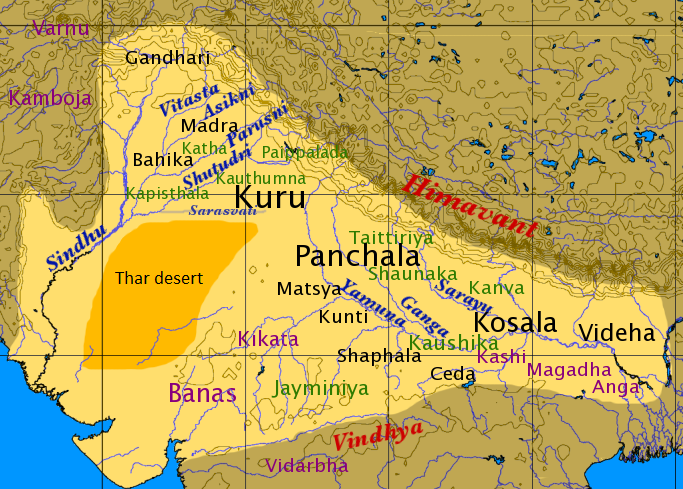 Image Source: Wikipedia
Image Source: WikipediaTHE MAHABHARATA - ADI PARVA [SECTION I]
Om! Having bowed down to Narayana and Nara, the most exalted male being, and also to the goddess Saraswati, must the word Jaya be uttered.
Ugrasrava, the son of Lomaharshana, surnamed Sauti, well-versed in the Puranas, bending with humility, one day approached the great sages of rigid vows, sitting at their ease, who had attended the twelve years' sacrifice of Saunaka, surnamed Kulapati, in the forest of Naimisha. Those ascetics, wishing to hear his wonderful narrations, presently began to address him who had thus arrived at that recluse abode of the inhabitants of the forest of Naimisha. Having been entertained with due respect by those holy men, he saluted those Munis (sages) with joined palms, even all of them, and inquired about the progress of their asceticism. Then all the ascetics being again seated, the son of Lomaharshana humbly occupied the seat that was assigned to him. Seeing that he was comfortably seated, and recovered from fatigue, one of the Rishis beginning the conversation, asked him, 'Whence comest thou, O lotus-eyed Sauti, and where hast thou spent the time? Tell me, who ask thee, in detail.'
Accomplished in speech, Sauti, thus questioned, gave in the midst of that big assemblage of contemplative Munis a full and proper answer in words consonant with their mode of life.
"Sauti said, 'Having heard the diverse sacred and wonderful stories which were composed in his Mahabharata by Krishna-Dwaipayana, and which were recited in full by Vaisampayana at the Snake-sacrifice of the high-souled royal sage Janamejaya and in the presence also of that chief of Princes, the son of Parikshit, and having wandered about, visiting many sacred waters and holy shrines, I journeyed to the country venerated by the Dwijas (twice-born) and called Samantapanchaka where formerly was fought the battle between the children of Kuru and Pandu, and all the chiefs of the land ranged on either side. Thence, anxious to see you, I am come into your presence. Ye reverend sages, all of whom are to me as Brahma; ye greatly blessed who shine in this place of sacrifice with the splendour of the solar fire: ye who have concluded the silent meditations and have fed the holy fire; and yet who are sitting--without care, what, O ye Dwijas (twice-born), shall I repeat, shall I recount the sacred stories collected in the Puranas containing precepts of religious duty and of worldly profit, or the acts of illustrious saints and sovereigns of mankind?"
The epic starts as a narration of the story by sutha to saunakathi munis, who reside in a sacred place called naimisaranya.(The map shows the place called saunaka, probably this place is near that. I think it is near Ayodhya.)
I guess Vaisampayana means the Suka acharya and Krishna-Dwaipayana refers to vyasa acharya. Ofcourse Suka acharya was the son of vyasa acharya.
The reference given to sacrifice of janamejaya:
Janamejaya was the son of parikshith who was the son abhimanyu and uttara, again abhimanyu was the son of Arjuna (One among the Pandavas) and Subadhra (The sister of Lord Krishna).
Well a short note on Janamejaya's sacrifice: Parikshith was bit by a snake called Dakshaka and of course he died!!(due to a curse) His son janamejaya enraged by this wanted to exterminate all snakes. So he started performing a sacrifice in which he burnt a lot of snakes. To prevent him and to enlighten him, Suka acharya narrated to him the puranas. I knew that the narration was devi-baghavatham purana, but dint know if others were included. It sounds like so here. The information in these vedic texts will be little fuzzy, the rishis might refer some text with some name, that might be common to other things also. Maybe its something to do with the sanskrit, which delves on the primal meaning....or rather say the inferred meaning of the author rather than the meaning of the text he employed to communicate that meaning.
And the sons of Kuru (The kingdom illustrated in the map) are the Kauravas and sons of pandu were the Pandavas. We shall properly introduce these people later, if you dont know. But there is one interesting thing here. The Kauravas who where the sons of Dhritarashtra, who was the brother of Pandu. Both can be considered as the grandsons of Kuru. The details of the eccentric circumstances of their birth will come later in the text. But we must keep in mind the question, 'why the sons of Dhritarashtra were called the sons of kuru and why not the sons of pandu?' If any of you know an answer for this, please comment.
I guess Dwijas (twice-born) in the text means the Brahmins who are twice born, one their natural birth the other at the initiation into vedas i.e, the Upanayana.
-----Anand Hariharan.
Maha.P002
0 comments:
Post a Comment